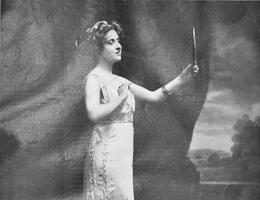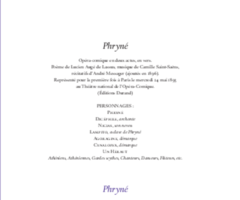Phryné
Opéra comique in two acts. Premiered at the Paris Opéra-Comique in 1893.
It is hard to imagine today that Phryné was one of Camille Saint-Saëns’ most popular and most frequently performed operas up until World War One—he himself conducted the 110th performance at the Opéra-Comique on 12 April 1916. Two composers – among others – expressed their admiration to the composer on hearing this little gem, which lasts an hour and a quarter. The first was André Messager: “My goodness, how delightful your act is!” (letter to Saint-Saëns, 14 February 1893). The other – Charles Gounod – wrote to Saint-Saëns 6 days before he died: “My Camille, thank you for your delightful Phryné. I will listen to it through my eyes (the musician’s second pair of ears) having been intoxicated by it through my ears, which are music’s eyes. With love and kisses. Imo corde [From the bottom of my heart].” (letter to Saint-Saëns, 12 October 1893). The work soon found success both in the French regions and in the international opera houses: vocal/piano versions appeared in French, Italian, then German. Because certain directors might have been put off by the distinctive nature of the spoken dialogue, André Messager composed some recitatives, published in 1909, which skilfully and seamlessly fitted into Saint-Saëns’ music. This “Messager version” was used for a well-received new production in Paris, in 1914. During this same period, Phryné continued to take the world by storm with critically-acclaimed premieres in The Hague, Brussels, Milan, Geneva, Algiers, Cairo, Monte Carlo… As late as 1950, the Opéra-Comique regularly revived this work, before it abruptly disappeared completely from the French repertoire.
Documents and archives

Press illustration, Picture of a scene, Photograph
Scène de Phryné (Saint-Saëns) au Trianon-Lyrique : acte I
Scientific publications
Publication
Camille Saint-Saëns. Phryné
Articles
Phryné in the press
Articles



